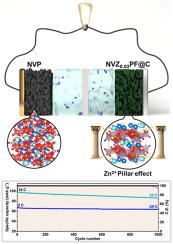Lattice engineering of Zn-doped Na3V2(PO4)2F3 for high-rate, wide-temperature sodium-ion batteries
IF 7.9
2区 工程技术
Q1 CHEMISTRY, PHYSICAL
引用次数: 0
Abstract
Zinc-doped Na3V2(PO4)2F3 emerges as a promising high-performance cathode material for sodium-ion batteries. In this work, we highlight the critical role of lattice fine-tuning, which was often overlooked in favor of improving electronic conductivity, as a key factor in enhancing sodium-ion mobility and ensuring long-term structural stability. This insight introduces a new design paradigm for robust cathode materials that can operate at high rates across a wide temperature range. Zn-doped NVPF (NVZ0.03PF@C) demonstrates that subtle lattice modifications can significantly boost electrochemical performance. Density functional theory (DFT) calculations reveal the material design strategy, with a reduction in bandgap, which correlates with enhanced electronic conductivity and improved ion transport. The lattice expansion and the Zn2+-induced “pillar effect” reinforce the crystal structure, enabling superior rate capability and cycling performance, even under ultra-high current densities. Notably, the material exhibits almost 100 % capacity retention after 1000 and 2000 cycles at 10C and 20C, respectively, at room temperature. Furthermore, a full-cell composed of NVP//NVZ0.03PF@C demonstrates excellent capacity retention, achieving 88 % at room temperature and 94 % at −20 °C, confirming its robustness across a wide temperature range. These findings position Zn-doped NVPF as an up-and-coming cathode candidate for high-rate, wide-temperature-range sodium-ion battery applications.

高倍率、宽温度钠离子电池中掺锌Na3V2(PO4)2F3的晶格工程
锌掺杂Na3V2(PO4)2F3是一种很有前途的高性能钠离子电池正极材料。在这项工作中,我们强调了晶格微调的关键作用,它经常被忽视,有利于提高电子导电性,作为增强钠离子迁移率和确保长期结构稳定性的关键因素。这一见解为坚固的阴极材料引入了一种新的设计范例,该材料可以在宽温度范围内以高速率运行。掺锌NVPF (NVZ0.03PF@C)表明,细微的晶格修饰可以显著提高电化学性能。密度泛函理论(DFT)计算揭示了材料设计策略,减少带隙,这与增强电子导电性和改善离子输运有关。晶格膨胀和Zn2+诱导的“柱效应”增强了晶体结构,即使在超高电流密度下也能实现卓越的倍率能力和循环性能。值得注意的是,在室温下,分别在10C和20C下循环1000次和2000次后,材料的容量保持率几乎为100%。此外,由NVP//NVZ0.03PF@C组成的全电池具有出色的容量保持性,在室温下达到88%,在- 20℃下达到94%,证实了其在宽温度范围内的稳稳性。这些发现使掺杂锌的NVPF成为高速率、宽温度范围钠离子电池应用的一个有前途的阴极候选材料。
本文章由计算机程序翻译,如有差异,请以英文原文为准。
求助全文
约1分钟内获得全文
求助全文
来源期刊

Journal of Power Sources
工程技术-电化学
CiteScore
16.40
自引率
6.50%
发文量
1249
审稿时长
36 days
期刊介绍:
The Journal of Power Sources is a publication catering to researchers and technologists interested in various aspects of the science, technology, and applications of electrochemical power sources. It covers original research and reviews on primary and secondary batteries, fuel cells, supercapacitors, and photo-electrochemical cells.
Topics considered include the research, development and applications of nanomaterials and novel componentry for these devices. Examples of applications of these electrochemical power sources include:
• Portable electronics
• Electric and Hybrid Electric Vehicles
• Uninterruptible Power Supply (UPS) systems
• Storage of renewable energy
• Satellites and deep space probes
• Boats and ships, drones and aircrafts
• Wearable energy storage systems
 求助内容:
求助内容: 应助结果提醒方式:
应助结果提醒方式:


